A collection of celebrated writers share their best tales of beloved hunting buddies, mentors, camps, and cherished gear. The authors of these stories take readers’ imaginations to an Alaskan caribou camp, Montana’s antelope plains, horseback hunts, and a frozen Midwest deer forest.
Constant Companion
Through hundreds of thousands of shots, the author’s first bow taught him not just how to hunt, but how to live
By T. Edward Nickens
It had to be one of the first ones made. Bear Archery produced its Black Bear recurve bow from 1972 to 1978, and for Christmas ’72 I scored one as part of a set, with arrows, that my parents ordered from the Sears Wish Book. The first time I shot it, I was standing in the backyard in my pajamas, the Christmas Day sun barely over the treetops as I flung an arrow at a hay bale my daddy had placed there. With a 50-pound draw weight, the bow was too much for an 11-year-old to draw and hold, but I’d insisted on one heavy enough to kill a deer. And inch by inch, day by week by month, I worked into full draw. From then until I left home for college, I shot that Black Bear bow nearly every day.
For much of my youth, little mattered as much as a tight arrow group. When I could Robin Hood one Port Orford cedar shaft with another, I stepped back five strides and started again. This was inside city limits, and kids rolling by on their way to football practice would holler out “Nature boy!” in derision. I shot through the jeers. Fifteen yards, 20 yards, 25.
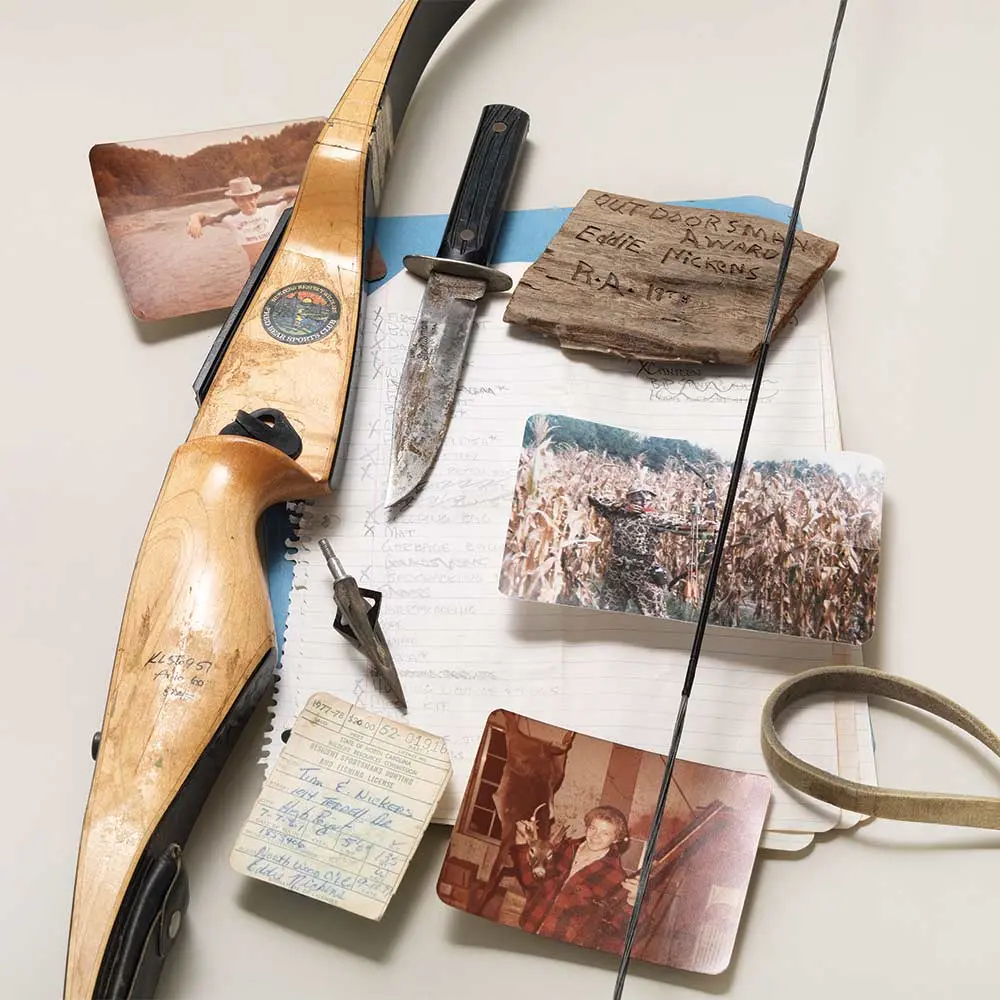
The author’s first recurve bow can still shoot. (Jim Golden)
I joined the Fred Bear Sports Club and roamed the woods behind the house, shooting stumps. I killed rabbits, squirrels, and a single dove I felled in flight with a flu-flu arrow tipped with one of those giant wire bird heads. I shot and shot—through acne and junior-high angst, and through the grief of my father’s early death. Shot through the tears when Denise Gurley dumped me for Bill Jarrett. Thirty yards, 35. I shot until “nature boy” became a badge of honor.
I never killed a deer with that bow, but how I tried. In the 1970s, deer populations were rebounding in North Carolina, but getting one in bow range was no easy task. I hunted from the coastal plain to the Uwharrie Mountains, scaling trees with a homemade climbing stand. I eventually capitulated to a three-pin bow sight, and I honed Bear Razorheads on an Arkansas whetstone. But the closest I came to an arrow-killed deer was pulling up with my mentor, Keith Gleason, to a Gates County cornfield in the dark. Our pal Ed Crabtree stepped into the truck’s headlights and held out an arrow smeared tip to nock with the blood of a deer he’d shot. During all those hours in the backyard, the concept of killing a big-game animal was abstract. But there’s nothing abstract about a bloody arrow. I was so excited that after the next morning’s hunt, I set up a portable target beside that very cornfield and shot and shot and shot.
In time, I upgraded to a compound bow and relegated that beloved Black Bear to bowfishing. Later in life, I stored it in an old hard case and hauled it from house to house. For more than 20 years it lay in dark corners of various basements, until I hung the bow in my son’s room when he was little, a sort of talisman that I hoped had a power that could cross generations. I would pull it down now and then, after bedtime stories with Markie and Jack. In the dim glow of a night-light in the hallway, I would draw the bow, relax my grip, and aim an imaginary arrow.
That bow opened a door that led from my backyard inside city limits to a limitless world of woods and prairies and tundra. But it did more than turn me into a hunter. It taught me discipline. The value of process. The burden and reward of a single-mindedness of purpose.
At one point, early in my education as an archer, I wrote on an index card the steps to follow for a good shot and taped it on the flat of the limb that faced me at full draw so I could read them. That was more than 40 years ago, but some things don’t change. Firm stance. Concentrate. Smooth pull. Follow through.
And take five steps back when the challenge is gone.

A solitary bull caribou moves through the tundra. (Donald M. Jones)
How Fate Gave Me a Day with Nothing to Do
At a remote Alaska caribou camp, the author catches a break and tags out early—then makes the most of it
By David E. Petzal
Once in a great while, whatever force controls our destiny gives a hunter a break. You punch your tag early on and then get to loaf in camp while everyone else goes out and busts their hump in the rain, snow, and cold. I got one of those days in a caribou camp about 70 miles east of Dillingham, Alaska, in the early 1990s.
Caribou are flighty creatures, and hunting them is a case of feast or famine. They can come clickety-clicking right through your camp in brigade strength, or you can walk yourself to death and never see one. On this occasion, with no effort at all, I had killed a nice bull caribou the day before. We took a boat ride. I walked up a short trail to the top of a bluff that overlooked a traditional caribou river crossing. (Caribou are big on tradition.) We planned to wait there until something showed up, but no sooner had I racked a round in the chamber when down the trail to the river came a small herd with the bull in the lead. In a situation like this, the prudent hunter waits until the herd is across the river and onto your side so that you don’t have to wade into the water to haul out a soggy 300-pound animal.
Obligingly, the bull crossed, and I shot, and that was the end of the hunt for David.
The next day, I had the option of going out with the other two hunters or loafing. I chose the latter, since one of the guides was a transplanted Montanan whom we called the Energizer Bunny because he walked very fast and never stopped and never slowed down.
And loaf I did. Nearly a quarter century later, I’m hard put to tell you why I enjoyed that day so much. Perhaps it was simply being in true wilderness. The nearest town, as I said, was Dillingham, which had a population of about 2,600 and was reachable only by plane or boat. I might as well have been on Mars. There were no planes in the sky, and no sounds except the wind and the splash of a fish and the chattering of camp robbers.
I remember sitting and watching the river that flowed by camp. I remember looking for something for lunch and finding a can of Argentine beef (at least that’s what the label said; I have my doubts) that was roughly one-third gristle, one-third fat, and one-third salt. It tasted terrific. I split firewood for a while.
Around 3 o’clock, the perfect, sunny day turned dark, and the rain began. It poured. I started a fire in our tent and one in each of the other two tents. The other hunters and guides arrived about then, soaked to the skin, wiped out from having run up and down every mountain in sight, without a caribou to show for it.
I, however, was dry, rested, and smug, belching Argentine mystery meat and expressing sympathy that I did not feel for their suffering.
The next day, we broke camp and floated downriver to meet the plane. It was on this trip out, I think, that we were waiting for the plane on a sandbar, and it was cold, so we built a roaring fire. When the fire got going, a bull moose stepped out of the reeds and watched it with us, just one of the gang.
Looking back, I’ve tried to figure out what made this day a gift. Probably, it was simply catching a break. You don’t get that many breaks in this life.
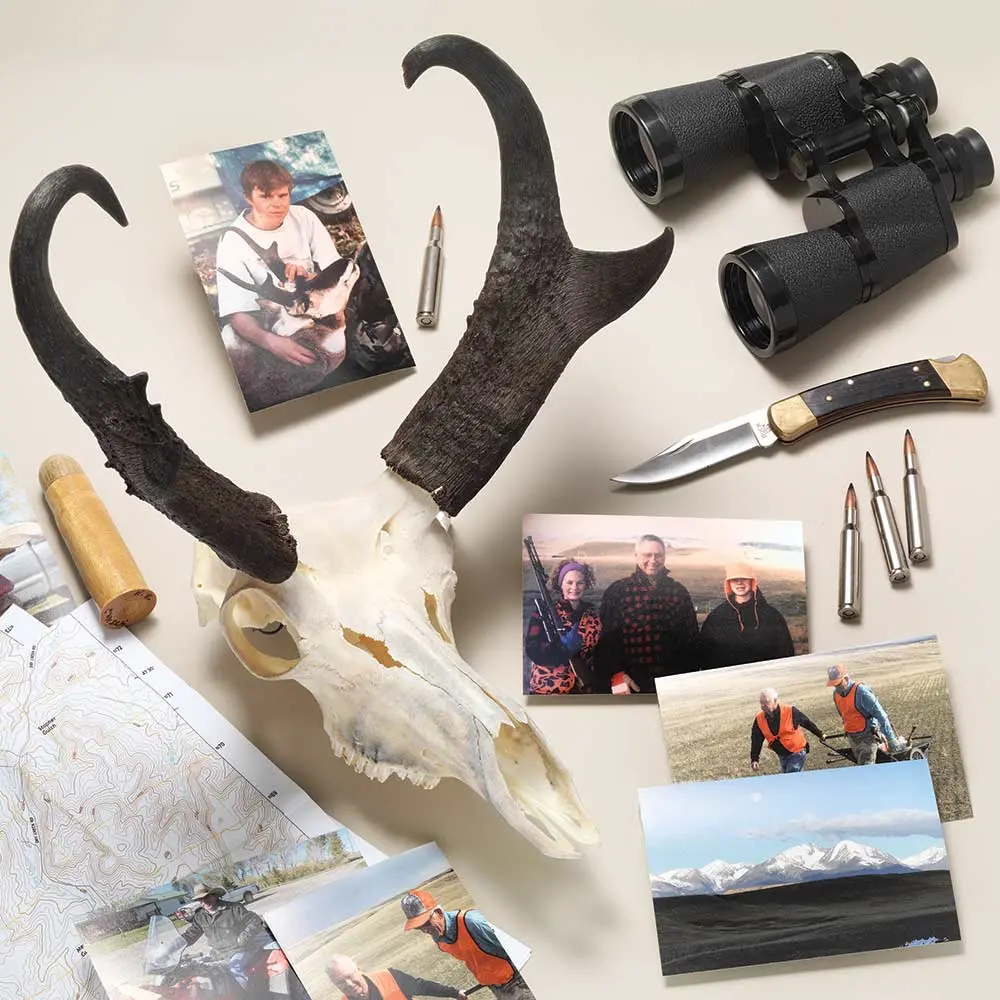
Mementos from a decades-long hunting tradition. (Jim Golden)
Wise Men of the Prairie
After 30 years of hunting antelope with the same friends, the focus isn’t on filling tags, but on something richer
By Keith McCafferty
John Thorp started the tradition. A truck driver with half of Montana unrolling before his windshield every week, he spotted an antelope standing sentinel on a high bench, fingered the tag in his pocket, and found the right door to knock on. The rancher, Roger Indreland, looked to have been born wearing a duster. He was salt of the earth, but then so was John, a farm kid who had grown up in North Dakota. A handshake more than 30 years ago, and we have been hunting these mixed-grass prairies ever since.
There are five of us: John and myself, Dean Center, Mike Connell, and Ted Hanson. We started here as young men who emphasized shooting straight and hanging horns, but in time that changed. As with all hunting traditions, it has become less about the game and more about the ritual and the memories. Hiking under the stars, the stalk, the shot, the drawing of knives, and the handshakes all. “Next year. Next year.” At some point, you realize that the seasons you have left for this are finite, and the crosshairs of the scope shift, magnifying those aspects of hunting that have nothing to do with pulling a trigger.
This fall, I am missing opening day for the first time in years. My mother, 96, is slowly fading like the black-and-white photos we have of her as a girl, and I’m reluctant to travel out of cell range to hunt, in case I get the call I know is coming.
As the day begins, the windows to the past open, and I am out on the prairies with them, if only in spirit. I know the pre-hunt ritual, for it never changes. Rising at 4, I drive two blocks to Dean’s house, where he is standing in his big wool trousers. He throws his gear in, and we head east past the southern toes of the Crazy Mountains. As we pull into the rancher’s driveway, the house all dark, no life but for the ranch dog that greets us, I tell Dean the same story I always do, for the dog reminds me.
My habit has always been to leave a game cart inside my unlocked truck, in case anyone needs it before I do, and then I place the key under the right front tire. On the morning in question, I’d shot a good buck, dressed it out, and hiked 3 miles back to the ranch for the cart, only to find the doors locked. Suspicion fell on the dog. Perhaps he’d seen me place the key. It was the type that locks and unlocks the doors with a button. Could he have clamped down, locking the doors with his teeth, and then run away with his prize?
Soon the rancher, Roger; his wife, Betsy; and their tow-headed daughters were scouring the yard in a kind of October Easter egg hunt. I finally found the key where the dog had dropped it, some couple hundred feet away from the Explorer. We all had a good laugh, and I remember looking around, the Crazies mantled with snow, the slanting escarpments impossibly rugged and beautiful, and these good people who worked the land and were kind enough to welcome me onto it, and even help look for my keys, and I thought, I am a very lucky man.
Among the most treasured of my memories are the times our group expanded to include my son, Tom, and John’s daughter, Rachel. They began hunting with us when they were 12. Both would shoot their first antelope here. I remember dragging Tom’s buck out and curious cattle blocking out the moonlight, Tom sticking close to me, leery of the barrel-bodied animals. Rachel, as she often said, liked everything about hunting “except for the walking part.”
Tom liked the walking part a little too well, and some mornings, as often as we would stalk a band of antelope, we’d take that one step too many, and the animals would bolt away. We’d trudge back to the truck for lunch and then go out again in the evening, accompanied, for a short distance, by a woman who owned an adjoining property and would take evening strolls with her cat. She’d wish Tom luck and turn to walk back, and when she crested a little rise that put her out of sight, we might as well have been the only people on Earth. We’d hike through the empty landscape to stand watch, hoping antelope would walk by. Usually, one did.
But our children have all grown up and moved away to start their own families. I’m a grandfather now, and though Tom still comes out every year to bowhunt elk with me, he has not hunted antelope for some years.
Out here on the plains, we are back to the nucleus of our group, and there is no one walking in our shadows. The later generations aim with their fingertips now; the prey they seek is on a screen. Their attitude toward the outdoors influences the land itself. The owners of many of the working ranches here hang on to them by a thread as one by one their kids move on; the ranching life just isn’t for them. Hang on another year, hope the per-acre goes up, and sell to the subdivider. Big Sky country, a little less so each year.
But for now, our corner of the dream remains intact, even if the gifts of opening day are no longer centered in the scope. A few years ago, looking out upon the bowl of a vast basin, I watched a badger digging a hole, the earth flying. The badger, standing tall on all fours to take stock of his work, pranced around the hole, looking like he owned the prairie. Another time I stumbled into a prairie-dog town and sat down to eat lunch while one, then another, then another popped out of their holes to imprint against the snows of the mountains. I listened to them calling to one another for a couple of hours. Did I shoot an antelope that day? Or the day I saw the badger? I have no idea. Nor do I recall shooting one the day that Dean Center handed me an exquisitely carved piece of his woodworking, a maplewood cartridge case with a removable wood bullet to commemorate the publication of my second novel. It’s occurred to me more than once that I might as well be hunting with one. Blood cools with age. As often as not these days, the antelope that come within range of my rifle walk out of it, and I feel none the poorer for not having pressed the trigger.
This year, of course, isn’t about the rifle at all. It is about my mother, who crowds these memories of the hunt into proper perspective. And so the day passes, blessedly uninterrupted by the ringing of the phone. But then, at about 10 o’clock at night, I hear a rapping on the back door. I switch the porch light on. There stand John and Dean, a big doe antelope lying on the grass between them.
“Where do you want her?” John says.
They helped me hang the antelope. We all shake hands and say, “Next year.” I go back into the kitchen and rinse the blood off my fingers. My wife calls from the bedroom to ask who has come by so late.
“Wise men bearing gifts,” I tell her. “An antelope.”
“Not gold, frankincense, and myrrh?”
I don’t know what frankincense and myrrh are exactly, to tell the truth. But I know that gold is, ultimately, only a color, and I go back to bed, sure that I am richer.
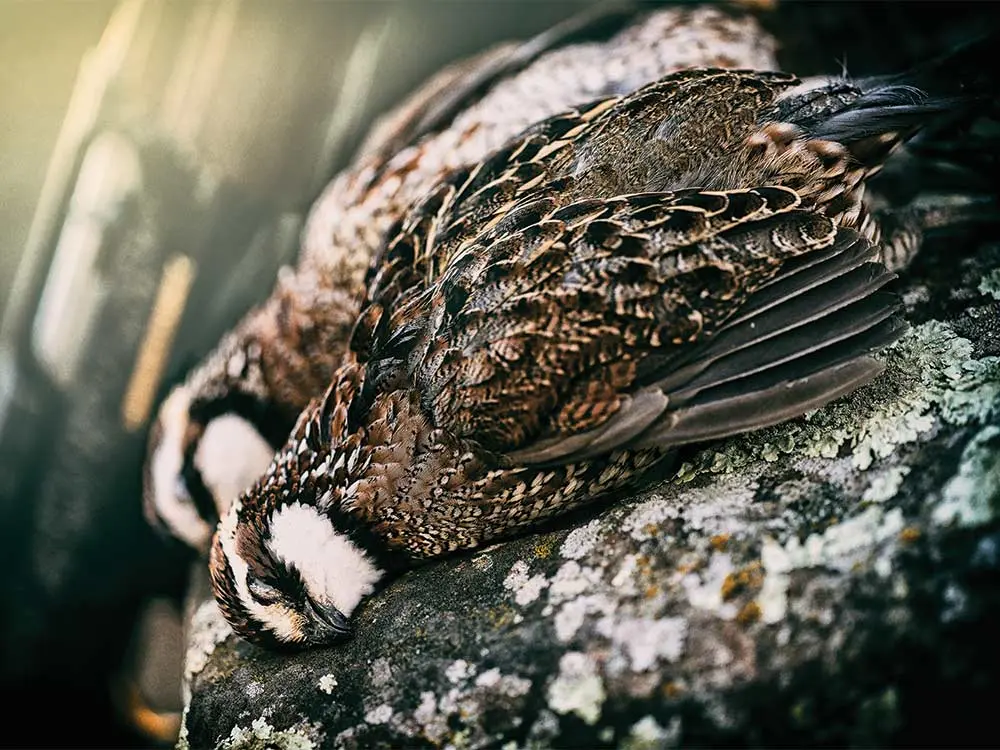
A brace of wild bobwhites, in early-morning light. (Aaron Hitchins / Rockhouse Motion)
Lil’s Last Hunt
On a final outing with the family’s bird dog, the author gets a glimpse of quail hunting’s heyday
By Will Brantley
I’m just old enough to have seen the end of Southern quail hunting. Yeah, there are still some plantations where a man can shoot at a pointed bobwhite, but bird hunting the way Dad did it was already fading fast when I was born. Dad saw it coming. The fescue, the coyotes, the clean fencerows, and deer leases seemed to be conspiring against quail hunters. When my brother and I were little, Dad told Mom: “I won’t make the boys play ball if they don’t want to. But at least once, they will walk up a covey of birds over a pointed dog.”
I was in middle school when he got his last two puppies. Sal was a lemon-and-white English pointer representative of the breed: hard-charging with a good nose and an indifference to affection. Lil was a small Llewellyn setter. She didn’t have Sal’s raw drive, but her nose was good enough. Better than that, she wanted to please. While Sal hunted with you, Lil hunted for you. Once, when she was young, Dad corrected her for marking a quail’s breast with a tooth. Her feelings were so hurt that from then on, she would only delicately pick a dead bird up to show it to you, and then place it back on the ground.
Sometimes after school, I’d take Lil hunting by myself. There were a few coveys within walking distance of the house, and because she worked close and would always come to me, I never worried about losing her. Killing a single bird was a good day.
Hunting with both dogs was reserved for the weekends and Christmas break, when I’d ride in the truck with Dad and his buddies for an hour or more to the last of their best places—farms that, without fail, used to be better. We shot quail, and my image of real bird hunters was formed. These guys cussed and argued. They didn’t carry over/unders because two shells made it tough to kill three birds on the rise.
Such a feat seemed impossible to me anyway, fast as flushing coveys evaporated into the brush. I’d usually empty my gun, but the best I’d ever managed was a lucky double with a single shot. “Pick one bird, and then the next,” Dad would say. “And always be ready for the late one.”
But with each season, the miles between points increased. Sal, with the yellow face, was the first to show gray on her muzzle. I got my driver’s license, and my buddies and I discovered boats and duck decoys. I stopped quail hunting with the old men. Dad would often tease me and ask, “Why would anyone get up that early to shoot a greasy duck when they could hunt birds?” But he knew.
Dad gave Sal away when I went to college. Lil retired indoors. After a life in a kennel, she’d taken to sleeping on a cushion at the foot of my parents’ bed. One fall weekend when I was home from school, a buddy of mine called to say he’d flushed a covey of birds while bowhunting his grandmother’s farm.
The place was only 70 acres, with a small beanfield and dense blackberry thickets, a property reminiscent of another time. Lil rode in the bucket back seat of my truck to get there, and when we parked, she bounced right toward a blackberry patch and was on point by the time our guns were loaded. When the covey flushed, the shooting was easier than I remembered. I knocked down two. We picked up a couple of the singles and moved on.
We found three coveys, all told, in two and a half hours. The last boiled from a stand of volunteer kobe lespedeza, right at Lil’s nose. My first two birds fell in plumes of tawny feathers. A late bird rose at the shots, and as it banked left to right, I downed it with my final shell.
Lil wouldn’t bring the birds to us; that lesson from her youth ran deep. So, we scrambled to retrieve them, laughing as she found each one, picked it up, and placed it gently back onto the ground. Our vests were brimming. It was the best day of bird hunting I’ve ever seen.
It was also the last, for Lil and me both. I haven’t quail hunted since, and Lil spent her last year mostly curled up on her warm cushion. To truly understand the “good old days,” you need to have lived them, if only for an afternoon. For a couple of hours in the sunset of her life, that was Lil’s gift to me.
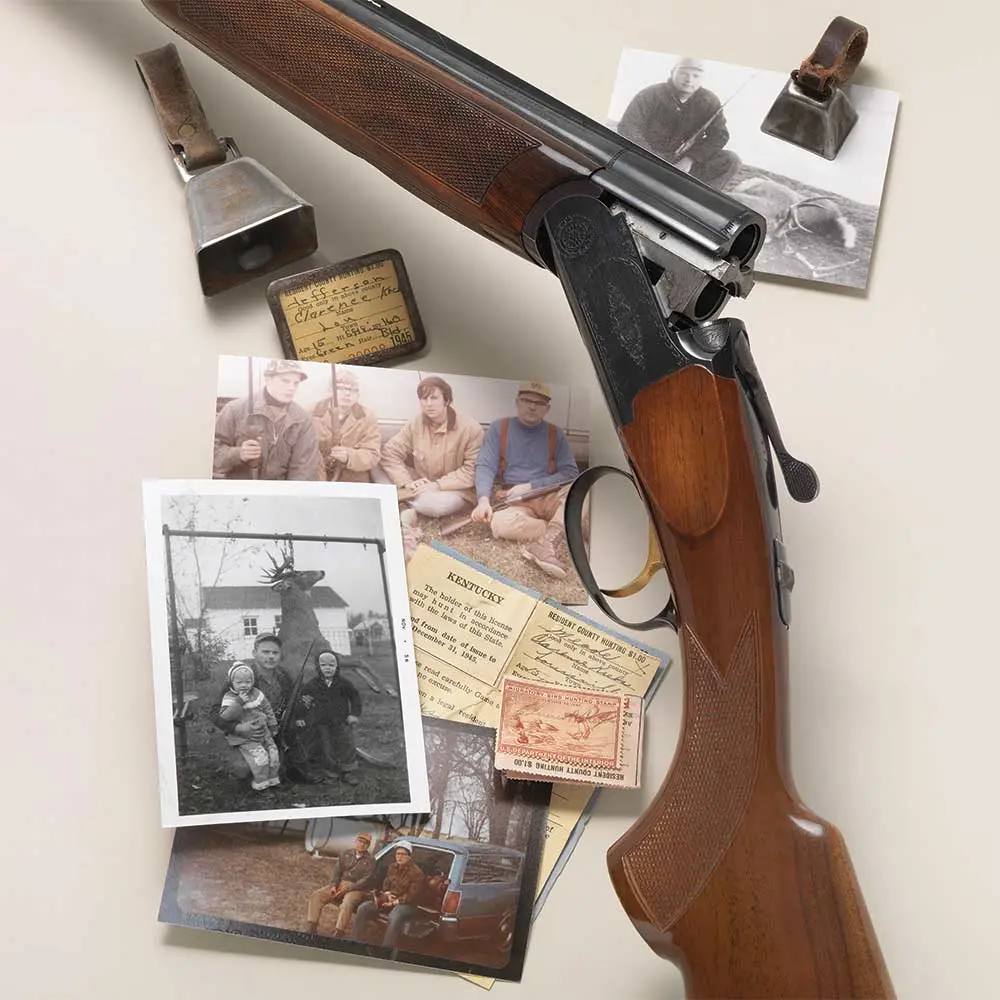
A collection passed down to the author. (Jim Golden)
A Hunt with Poppa
Better late than never, the author gets the outing she’s always wanted—and much more
By Natalie Krebs
“If we don’t find any squirrels, we’ll go back to the cabin and shoot them off the bird feeder,” my grandpa said as we walked into the woods, flashing me a wicked grin. Poppa wore a faded work shirt under denim overalls so bright they must’ve just come off the shelf at Tractor Supply. He topped the outfit off with a squat trucker’s cap, and he carried a shotgun in the crook of his elbow. It was only the first week of the small-game season, but this hunt was long overdue.
We eased down the two-track that bisects my uncle’s 40 acres, a hardwood lot sandwiched between the state highway and a wall of pines that marks the Hoosier National Forest. I carried a Savage .22, a choice Poppa thought foolish. The proper gun was an Italian-made 20-gauge, specifically the Charles Daly Field III he carried. It was a pretty little over/under that he’d rescued from a yard sale the year I was born.
Satisfied that we’d walked far enough from the cabin—about 50 yards—he lowered himself onto a dead oak beside the two-lane. The shotgun rested across his 85-year-old knees. I joined him, and leaned back to search the branches above. Soon my thoughts began to wander, as all hunters’ thoughts do when it’s time to wait.
A joke (or maybe it wasn’t a joke at all) about popping yard squirrels wasn’t the sort of thing Clarence Krebs indulged in when I was little. Poppa had always been stern, a German Catholic engineer with eight kids, then 17 grandkids, but no time for nonsense. I spent my early years avoiding him, or saying little when that didn’t work.
Then Poppa retired, which cheered him up considerably. But the process was like a beech letting its leaves drop—it took a while. Jokes become more common, though I could still say the wrong thing. Once, I told him I wanted to be an architect; he made it clear I didn’t want to do that. Architects, he said, dreamed up problems that engineers had to fix. I just nodded. Later, when he heard I wanted to be a writer, he didn’t say anything at all.
A rustle drew my attention to a high branch where paws fussed behind a screen of leaves. I whispered, then remembered Poppa probably wouldn’t hear if I fired three distress shots into the air. So I tapped his shoulder and we argued over who would shoot. I won by setting my rifle aside. The squirrel twitched, and Poppa pulled the trigger.
To meet me here, he drove over the Ohio River, across a bridge he’d helped create. Poppa often spends weekends looking after the farm and faithfully observing happy hour before supper. Once, when I’d grown old enough to crack a beer without getting in trouble, Poppa taught me to drink it by tipping my head instead of the bottle. He insists it’s cooler. Another time, he’d called me to sit beside him on the porch.
“I know you like old things,” he said, placing a burlap shot sack in my hand. Inside were two battered bells on leather straps, a brass quail call, and a metal pin that read “State of Kentucky” in raised letters. The pin held Poppa’s 1945 hunting and fishing licenses, lettered in a careful hand, and a duck stamp from 1946–47. Each had cost $1. I considered the dates. His dad had died in 1944, just after Poppa turned 14. He’d hunted by himself, mostly, in ’45 and ’46.
“You don’t have to keep them,” he said. “I don’t know what you’ll do with them.”
I protested and held them closer, heirlooms that some might mistake for junk. Buried down the hill from where we sat were Poppa’s two Brittanys. He’d told me often about the travesty of modern e-collars, when nothing was so sweet as those clanking bells. Beside us sat my grandma, lost in the fog of Alzheimer’s.
The leaves exploded, and the squirrel scrabbled around the trunk uninjured. Poppa’s face clouded. I had guilted him into this outing, our first squirrel hunt together. He’d taken some of his grandsons squirrel hunting when they came of age, but none of them took to hunting. His granddaughter did, but he never asked me to go. So when I was almost 25, I demanded a squirrel hunt with my grandpa. In the end, he killed one, and I never took a shot. It was perfect.
A few years later, Poppa called me down to the workbench, where a gun case lay. Inside was that pretty little over/under. On the trigger guard was a tag in the same hand as the hunting licenses, a slight wobble to it now. It read, This 20 gauge, fixed choke, is for Natalie. —Poppa
Later I learned that he’d intended to leave me the Charles Daly in his will. He’d labeled it and locked it up until that unhappy day. Instead, my dad persuaded him to get some joy out of the transfer and give it to me himself. So he did. With each gift, he passed along his memories to someone hungry for them before they didn’t mean anything to him or to anyone else.
Lately when I see him, usually with a glass of Wild Turkey in hand and hearing aids turned up, he starts off saying, “Aw, you’re not still hunting all the time, are you? Running all over the place? It’s not right. You don’t want to do that job forever.”
It’s part jest, part genuine disapproval. These days, I don’t nod. Instead, I tell him, with a wicked grin on my face, that if he disapproves so much, he shouldn’t have given me his shotgun.
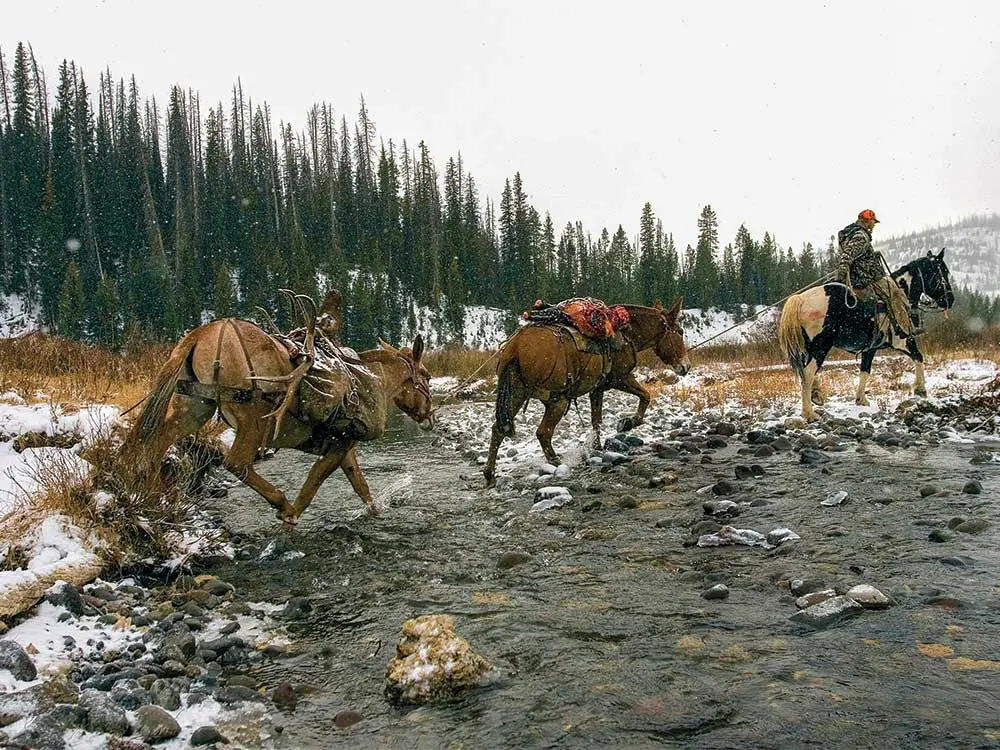
Hunter, horse, and mules pack out a nice bull elk. (Denver Bryan / Images on the Wildside)
Back on the Horse
Courage isn’t about not being afraid. It’s about doing what you’re afraid of
By Dave Hurteau
Once, on a slope of deadfall in the Colorado backcountry, my hunting partner lost it. He threw himself off his horse, collapsed onto the ground, and refused to go one step more. He’d freeze on the mountain if need be.
Matt wasn’t afraid of the darkness that had fallen—although the nighttime woods do frighten some hunters. An elk outfitter once told me about a client who, as dusk fell, spotted lights far in the distance. The hunter threw down his gun and ran for it—7 miles to the nearest town, where one of the guides was getting supplies and recognized him. “What the heck you doing down here, Joe?” the guide asked.
“I guess I got a little carried away,” the hunter replied.
And Matt wasn’t troubled by the fact that we’d lost the trail. Or that we were still miles from camp. No. His face, which was illuminated on one side by moonlight that filtered down through pillars of aspens, was twisted in fear because of his stubborn horse, which instead of stepping over the blowdowns, kept leaping over them—again and again and again until Matt unraveled.
“That’s it!” he yelled, whipping a leg over the saddle. “I’m done.” I wasn’t sure who he was addressing at first, me or our guide, until I realized that he was wailing into the night itself. It didn’t make any sense. We just needed to relocate the trail and we were home free. But we’d moved beyond making sense. “I’m not going any farther!” He was scared.
I knew exactly what Matt was feeling because I’d felt it too—that overwhelming, irrational dread, that suffocating panic—just days earlier, in the foyer of my home, trying to steel myself to walk out the door, get in the car, and then board the plane to Denver for my first media-junket elk hunt.
At the time, my social phobia was so bad that even a dinner party with friends would elicit an animal fear—something akin, I’m guessing, to being chased by lions on the savanna, plus a nice dose of shame at the ridiculousness of it all. Turns out, knowing that your fear is silly doesn’t tame it any more than does knowing that other people are afraid of equally silly things. I once had an F&S colleague who was terrified of squirrels, which I assume are easier to avoid than people. I can’t tell you how many times I’ve thought, I wish I were afraid of squirrels.
For me, a week in a wall tent with strangers—a dream hunt to anyone else—seemed like a nightmare.
Matt’s fear wasn’t so absurd. That horse had been screwing with him all day, slowing down to munch wildflowers and then rocketing into a gallop to catch up. Jumping over every obstacle. When we lost the trail on the ride back to camp, after night fell—and especially when we entered the maze of deadfall—it all became too much.
So, we sat there in the moonlight, the three of us, not saying anything for a while, just bearing the cold air, tinged with fear and awkwardness. Then Matt got back on his horse, and we rode back to camp.
The next morning, I awoke in a panic. A group breakfast first thing can be a terrifying prospect, believe it or not. I pretended to sleep until my tent emptied, and then I lay there feeling stupid and thinking I’m not cut out for these kinds of hunts.
Eventually, I got myself to the main tent, where everyone was busy eating and making plans for the day. Because there were more hunters than horses, the guides asked who wanted to ride. To my astonishment, Matt was the first to volunteer. Outside at the stable, I saw him standing with Baxter, the same horse from the day before. I thought it had to be a mistake. I walked over and gave Matt the reins to my mount, who was gentle. And Matt handed them back to me.
“Thanks,” he said, “but Baxter and I are going to go back up there and work things out.”
All these years later, I wonder if Matt remembers that exchange, or knows what a gift he gave me with his example. I’ve never forgotten it. I arrowed my first bull elk that week on what turned out to be a dream hunt after all—just one of many similar trips I’ve managed to go on since. All because Matt got back on that horse.
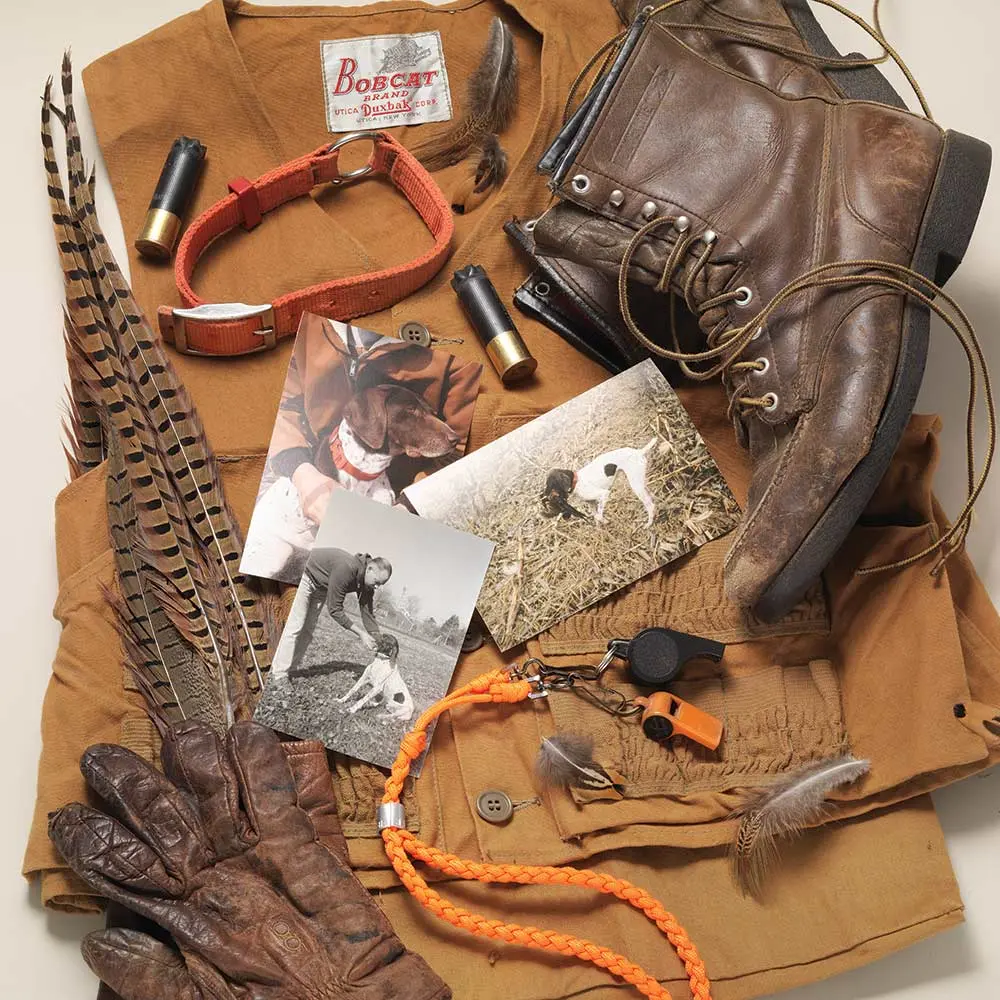
Snapshots of Sam bring old hunts back to life. (Jim Golden)
Pointers From Sam
After a few fits and starts, the author’s bond with his first gun dog proved life-changing
By Phil Bourjaily
Vern repaid an old debt to my father by giving me a dog. One undersize misfit sat off by itself in his yard full of athletic German shorthairs. The dog saw me and barked. “That’s the dog I had in mind for you,” Vern said. “Some guy in Ohio sent him back, said he was too small and wouldn’t hunt. We’ve been calling him Pee Wee.”
You’re not supposed to look a gift horse in the mouth. If I did, I’d have seen an underbite. Pee Wee had other problems too. He was the runt of his litter and had spent the first year of his life neglected in that Ohio man’s kennel, leaving him socially stunted as well as scrawny. I put him in the back seat of my VW Beetle and changed his name to Sam on the ride home—for his self-esteem and mine.
We were a pair—Sam, rejected and regifted, and me, floundering toward the end of my 20s. Having failed to find a career or even a full-time job, I was just discovering that people would pay me to write. Problem was, all I wanted to write about was hunting, and I had come to it late and didn’t know much about it. My ignorance extended to dog training.
A run at my mother’s farm seemed like a good first step. Mom and I were walking down a trail in the woods when Sam bolted. I learned then that my dog had two speeds—fast and gone. These sudden sprints would become the theme of the next few seasons.
At some point during any hunt or run, Sam would make the jump to hyperdrive, sometimes chasing something, other times just making a beeline to freedom. I tried whistles, check cords, and a pair of rubber balls that hung from his collar to bump against his legs and slow him down. Nothing worked. I was hoarse through November and December. We’d walk out of the house together, I’d lose him, and often he was waiting for me when I got home.
The airplane was the last straw. Most dogs, even if they haven’t been steadied to wing, soon learn they can’t catch flying birds. Sam never did. He would run as far as they flew. One day, he even chased a low-flying single-engine plane for more than a half-mile until he was a tiny white dot against a black plowed field. Only the fenceline stopped him. On the way back, he bumped a rooster. When I realized the bird was flying right at me, I stopped blowing the whistle and yelling, and hid behind a tree. I stepped out and shot the incoming pheasant. Sam arrived in time to point it dead where it fell at my feet.
This was no way to hunt. I started saving for an electronic collar. Electricity solved what all the other remedies did not. Sam soon believed there was something out there that could hurt him, and he stayed closer to me for protection. It marked the beginning of our bond. Unfortunately, e-collars back then spent more time in the shop than they did in the field.
I knew enough about dog training to know that you have to correct dogs in the act, not after the fact. Running shoes proved the low-tech answer. Every day during our off-season walk around the east 40, Sam left me to run the perimeter. I did the math: If I sprinted to the far corner of the field when Sam took off, I’d have roughly 250 yards less to travel. I wasn’t in his league for speed, but I’d have a head start and desperation on my side. The next time he disappeared over the hill along the fenceline, I called to establish that he was disobeying, then ran hard, reaching the far corner and hiding in the weeds before Sam arrived. I jumped out, screaming, and gave him a shake by the scruff of the neck. Sam paid me a lot more mind from that day on. Suddenly, in his mind, I could pop up anywhere.
As he reached his peak at 6 and 7, it became almost unfair to hunt birds with Sam. I started shooting trap and skeet so I could hit the birds my dog was pointing. I learned how to read a dog and a field, how to play the wind, and how to pinch and trap running pheasants. And the more I learned with Sam, the more I had to write about. Other useful lessons came at a higher price: how to get a dog out of a trap, why you never let them jump a barbwire fence, and how to break up a dogfight. That fight left Sam and me bleeding through eerily matching holes: mine deep enough to see the tendons in the back of my right hand, his in the back of his front right paw.
Late in Sam’s 8th year, he ran into a woodlot to retrieve a bird. When he didn’t come out, I went in and found him standing next to the dead pheasant, woozy and disoriented. I carried him to the truck. That night he had a violent seizure. I took him to the vet, sure that I’d never see him again, but she brought him back to life overnight. Sam was hypoglycemic, and his crashes were terrifying. His hunting days were over. He lived two more years.
I was out training the puppy that succeeded Sam the day he died. My wife was home, and she knew he was fading. “That’s OK, Sam,” she told him. “You can go now.” I had cried so many times for Sam when I thought he was dying that I had no tears left, just gratitude when I scattered his ashes on the hill where we killed his last pheasant. I had found a career writing about the outdoors, and Sam had pointed the way.
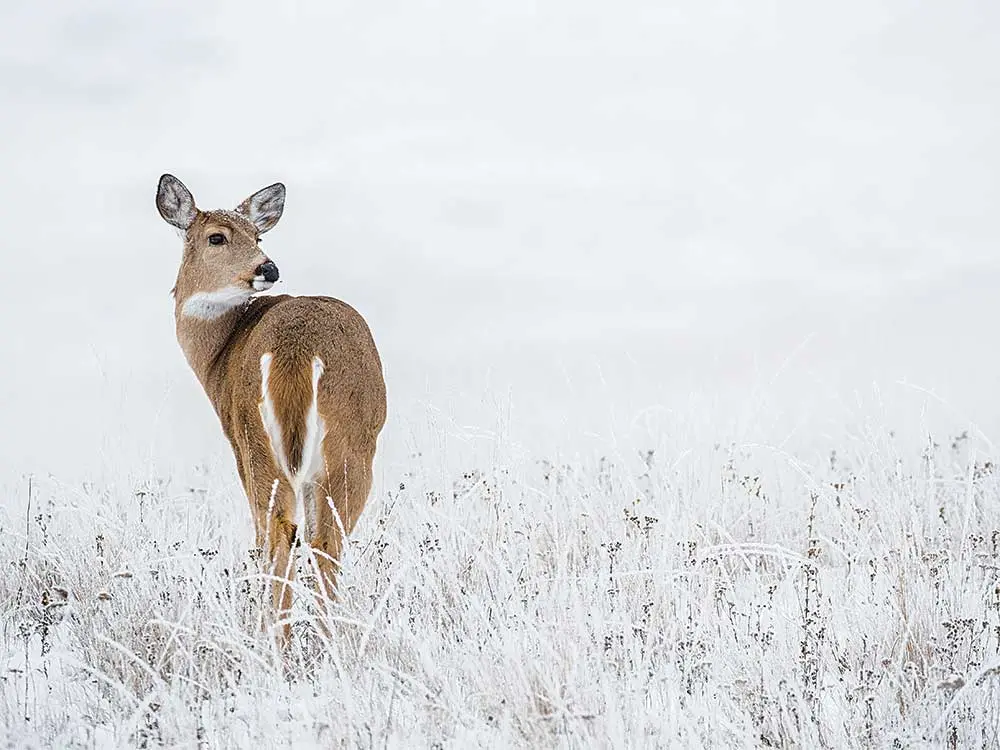
A whitetail doe checks her backtrail in a snow-frosted field. (Donald M. Jones)
Lost Soul
Still reeling from divorce, the author rediscovers himself in the hunt
By Scott Bestul
The hunt was over before it even started, and I knew it. I’d post-holed through 500 yards of knee-deep snow and had slowed to catch my breath before topping a rise that overlooked the picked beanfield. Peering over the crest, I met the gaze of a huge doe. She, along with another mature doe and four fawns, had been digging for waste grain right in front of my treestand. She foot-stomped once, then wheeled and ran, five bobbing tails following her into the hardwoods.
Most deer hunters have it wrong. The wariest deer in the timber does not wear a candelabra on its head, but a set of donkey ears. Any doe that’s raised at least three sets of fawns wakes up suspicious, breathes paranoia, and spooks on principle. Worse, every deer in the herd trusts her implicitly. One snort from an old matriarch will clear a field instantly, leaving very low odds that a single deer will return in daylight.
I knew I was in for a skunking, and a frigid one. I sighed and crunched my way to the stand anyway, as if accepting a punishment I felt I deserved.
I’d had a tough fall. Divorced only months before, I’d started the season in a slump. My best stands turned to duds, and all the deer I spotted were what I call “just-somethings”: just too far, just too young, just too…whatever. The worst part was that I didn’t much care—except for when it came to the Stranger Buck.
A huge, mainframe 8-point, the Stranger was a ghost of a deer, a loner that appeared and vanished. I’d had two encounters with him during the previous year and only a handful of trail-cam pics since, and yet he’d wiggled under my skin. He was probably the only thing keeping me in the woods that season.
Dealing with divorce isn’t a lot different from handling a death, and according to court documents, my marriage was officially dead in June. By the September bow opener, I’d settled into a kind of numbness that was better than the initial shock and pain but hung like a fog between me and anything that felt normal, let alone joyful. I knew my soul had to be in me somewhere, but I couldn’t make contact.
So I stumbled through the fall, and before I knew it, December had arrived, a month when snow and brutal cold can make for incredible, but challenging, hunting. Most years, it’s my favorite time of the season; this year, I was teetering. Did I really want to brave the elements, or just call it a year and hope my head was in a better place next fall?
I was leaning toward option one when I found the Stranger Buck. Conditions were perfect: a straight north wind, numbing temps, half a foot of snow on the ground. At midday, with three days of the season remaining, I headed out to hunt the one food plot I knew was in his wheelhouse. I felt a slight tingle stirring in me as I left the house, a buzz I’d scarcely felt in months.
As soon as I stepped into the plot, I spotted him, or rather his right antler, sticking out of the snow. The Stranger Buck had died within bow range of my stand, his body frozen solid, frost covering his forehead and tines. There was no blood or visible wounds. I pulled him free of weeds and snow and knelt beside him. “Oh, buddy… What happened?” I whispered as I felt a sadness hit me in a place I thought I’d closed off for a while.
So that was my state of mind when I bumped the big nanny doe and her entourage that final, snowy night of the late bow season. After spooking them, I crawled up a frost-rimed ladder into my stand and settled in to face the northwest wind. The sun had just touched the treetops when I spotted movement to my right, a shimmering of gray shadows against white snow. I counted six deer: a mature doe and four fawns, all following a huge, horse-headed nanny surveying the field before entering. It can’t be them, I thought. But it was.
I came to full draw as the big doe stepped into the field. All I recall was the sound of my bow at the release, and the sight of the arrow arcing in flight, and the quick-running circle of the doe as she spun to sprint back toward the woods before collapsing within sight.
Minutes later I knelt over that sleek, still-warm form, my gloved hand pressed against the fur of a deer that had no business giving herself to me. “Thank you,” I whispered into her huge, all-hearing ears. Then I looked up into a star-filled December sky and just stared—watching, listening, breathing…and finally sensing, at last, a tiny part of me returning that had not been present for what seemed like a very long time.
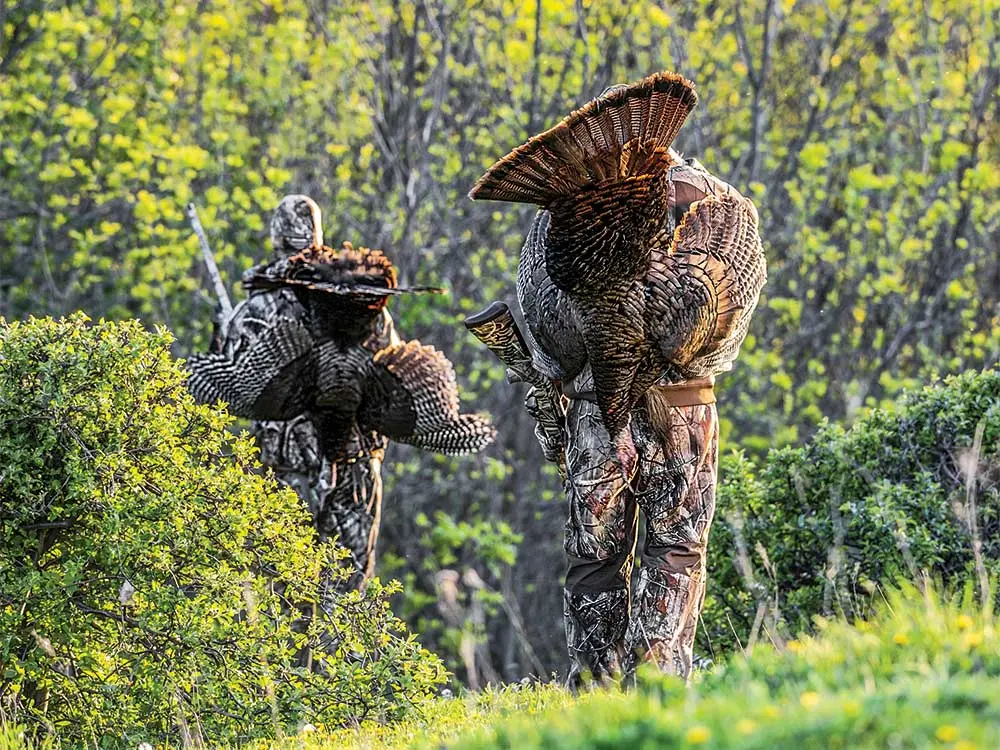
Hunters leave the spring woods with a pair of gobblers. (Lee Thomas Kjos / The Raw Spirit)
Uncle Tim’s School for Greenhorns
He was an unlikely addition to the family—and the perfect hunting mentor
By Michael R. Shea
Chain-smoking Newports in the country-club parking lot, sunburned in his wedding tuxedo, my soon-to-be Uncle Tim looked as twitchy as a Lab in a wetsuit. Someone told him my Aunt Martha was ready, the music struck up, then he sucked down one last nervous butt and marched into our family.
Lawyers, businessmen, and academics all, we didn’t know what to make of this foul-mouthed commercial fisherman. Did Martha know what she was signing up for? A guy who’s at sea more than he’s home? Who, when he’s home, spends most of his time hunting or training dogs. Twenty years later, all those concerns have faded away. We’re all grateful Martha kept him. But no one more than me, because Uncle Tim taught me how to hunt.
I moved out West in my early 20s, took an interest in duck hunting, then moved back East with a Remington 870. My mom didn’t want a gun in her house, so the Wingmaster went into Uncle Tim’s safe. That fall, he led me to the back channels of the Connecticut River to jump-shoot woodies and decoy mallards. In the spring, he took me turkey hunting. On those initial hunts, he’d bark at me like I was a greenhorn on his squid boat. “Pick up your feet,” he’d whisper-yell through gnashed teeth. Twenty steps farther: “Pick up your damn feet!” At least half a dozen turkeys lived another day because I was with him.
I’ll never forget the first bird he put me on. After walking all morning on state land, we struck a bird that came in hot. It was all but a sure thing—until, at 20 yards, the bird saw me slowly moving my gun barrel. The turkey bolted, and Uncle Tim shot up. “You got to swing! Swing!” he said, waving his arms, spittle building up in the corners of his mouth. “Look,” he said, “with deer, yes, you can move slow,” and he mimicked me moving all slow and dainty. “With turkeys, you don’t move! You wait until they go behind a tree, OK, then you swing fast, OK? Fast!” he said.
Two springs later, I figured I’d graduated Tim’s school of not being a greenhorn dummy when he called to see if I could help him kill an old state-land gobbler that he couldn’t put a tag on. “I got a plan,” he said. So I drove the three hours to meet him in the morning. We hiked in, then sat down together and waited for first light. Finally, Tim worked his mouth call, and that tom erupted 80 yards away and flew down. Tim hit the call again, and the tom answered but didn’t move. Then he told me to sit tight as he walked back a dozen yards and called, the tom cutting him off. Tim called and moved, called and moved, and pulled that old gobbler to the end of my gun. And when his head was behind a tree, I swung the barrel a few degrees—fast—and stoned him.
Uncle Tim and I have hunted turkeys this same way for years now—as a team, with one caller and one shooter. Two openers in a row, across the river from that old gobbler’s hill, we doubled on 2-year-old toms. He showed me the ropes duck hunting much the same way and put me in the stand where I killed my first deer. These days, we’re much closer to equals in the outdoors, but I never forget who my mentor is—because, well, I still have a tendency to drag my feet.
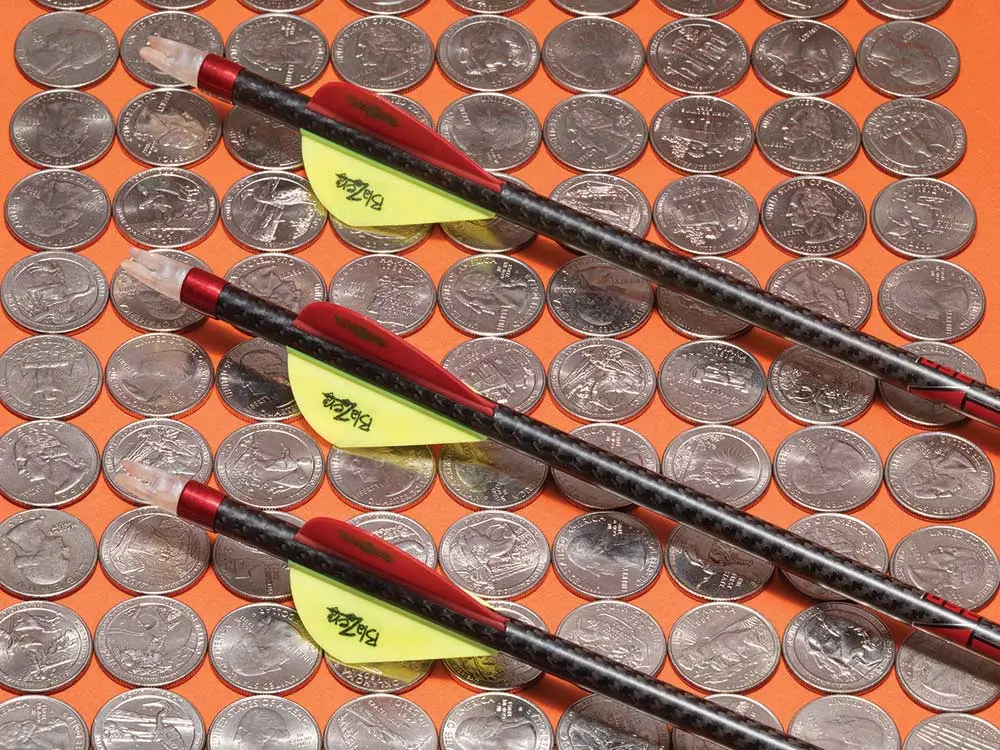
Betting a quarter a shot is an easy way to either improve your archery skills, or deplete your summer savings. (Jim Golden)
Killer Confidence
By Will Brantley
The men shot for a quarter an arrow at the summer 3D shoots, and at 15, I’d just started pulling a man’s bow. I stepped back to the grown-up’s shooting line, said something smart-mouthed about taking their money, and with no cash in my pocket, ended up in debt. It was made clear that if I wanted to shoot for quarters, I’d better be ready to pay up when I lost. Otherwise, the kid’s line was 10 yards closer.
I lost money at the end of most shoots—but not all of them. As September neared, I dug into my lawn-mowing savings and sprang for a half-dozen brand-new XX78 aluminum arrows. I showed them off to Dad’s buddy, Bobby, before one of the summer’s final shoots. “You sure you want to use those? You might lose them before the season,” he said.
I insisted, and bounced my first one off a pignut tree beyond a 35-yard target. Twenty-nine targets in, I’d lost four arrows. The final shot was a long poke at a foam turkey. With two arrows left for opening day, I almost skipped it. Bobby said, “Your shot, Will.” I stepped to the line and took a deep breath. “Hey,” he added. “Just settle in.”
I 10-ringed that turkey, and shook as I lowered my bow to cheers of “Good shot!”
I had to pay out some money that day. But the image of that final, perfect arrow, under pressure, came in handy days later, when I took my first bow buck. Bobby helped me drag it out.
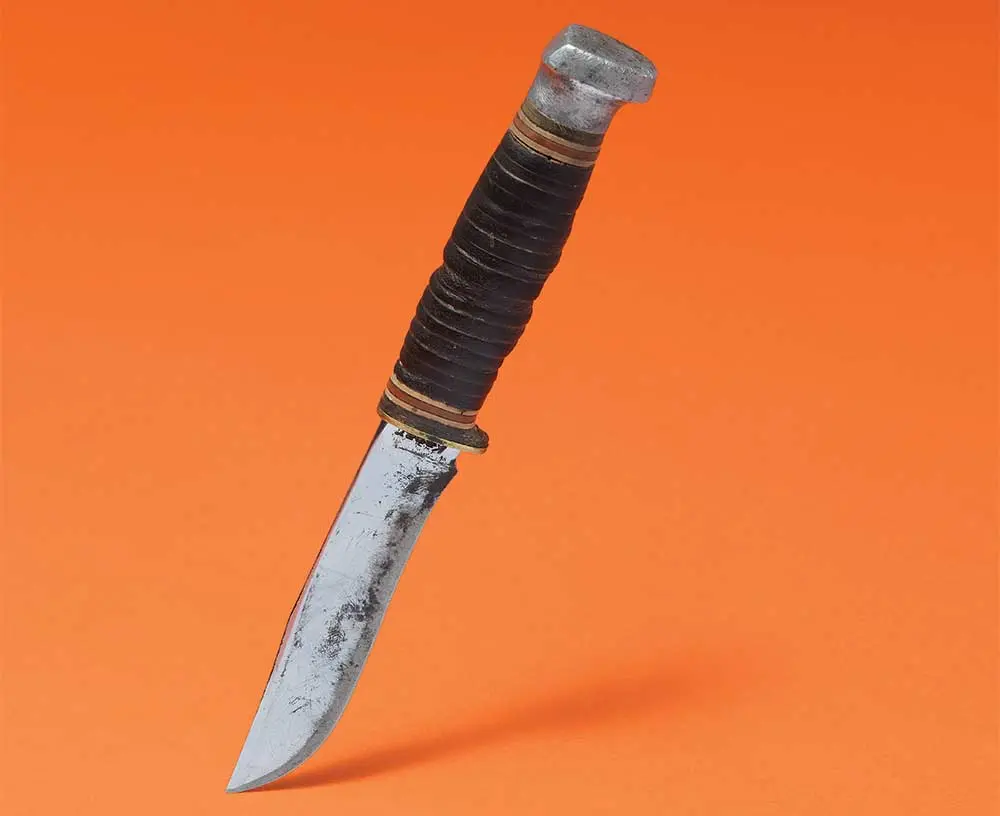
Heirloom knives are old and weathered, but more valuable than 100 news blades. (Jim Golden)
Dave’s Knife
By Dave Hurteau
I lose knives like people lose skin cells. A countless number have sloughed off me without my even noticing. For that reason, I’d never allowed myself to get attached to any blade. Then, a couple of years ago, F&S rifles editor David E. Petzal—my mentor—pulled this battered, stacked-leather Ka-Bar Hunter from his pack and told me a story.
One bitter evening in 1972, on a high alpine divide in Montana, Norman Strung (a well-known F&S writer) field dressed an elk with this Ka-Bar and then walked off the mountain without it. His friend Sam Curtis (also an F&S writer) asked if he could keep the knife if he could find it. In the spring, Sam climbed to the divide, rescued the knife, and used it for more than 30 years. Weeks before he died, Sam gave the knife to Dave, who had kept it for nearly a decade. Now he wanted me to have it.
This is the only knife that has ever meant anything to me. I can’t lose it. But I also can’t leave it in a drawer, forgotten. So before certain hunts, I strap the Ka-Bar to my belt. As I walk through the woods, I’ll reach for my hip every few minutes to make sure the knife is still there. Each time starts with a spasm of terror, but then the handle fills my hand, and I remember how I got it and who carried it before me, and a wave of gratitude rises up that I get to ride for a while—until I have to reach for it again.
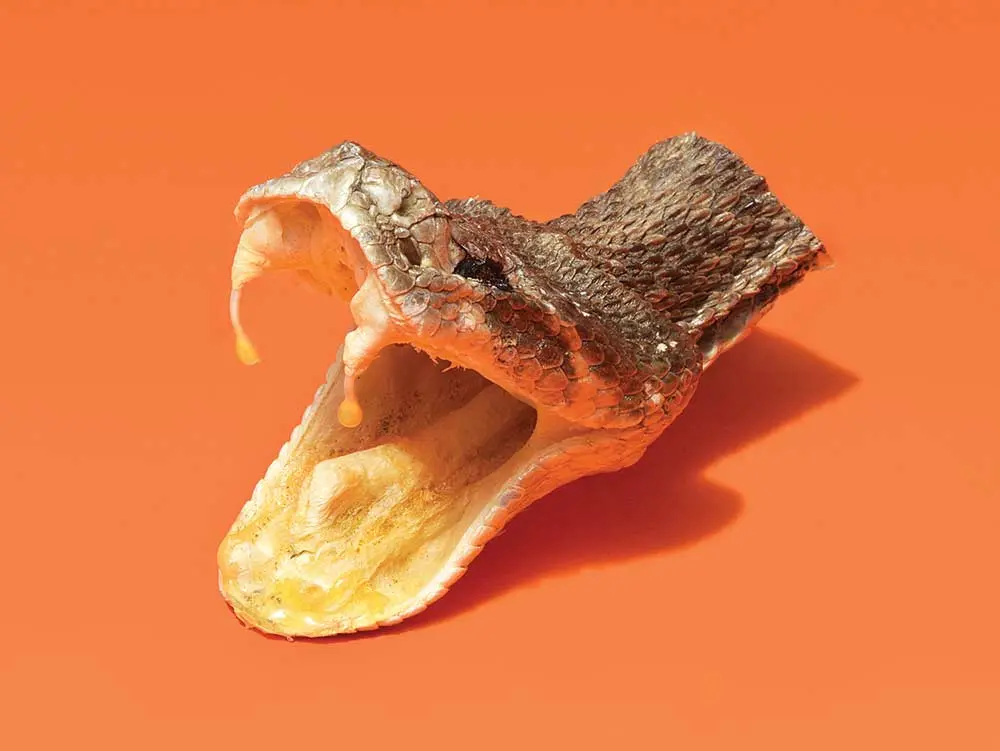
A gift with a bite: behold, the Western diamondback in a box. Jim Golden
You Shouldn’t Have. Really.
By David E. Petzal
On occasion, I have received gifts from colleagues, and some have not been in the best taste. One editor, for reasons now long obscure, sent me his newborn daughter’s dried umbilical cord. But the most memorable gift came from Sandy Brister, who was married to the late Robert Brister, longtime F&S shooting editor. Uncle Robert had a personality with more juice in it than a hot cattle fence, and Sandy was his equal. While Bob talked constantly, Sandy maintained a queenly silence.
Somehow we began giving each other gifts. At one SHOT Show, I gave Sandy a T-shirt that said _Jesus Loves You_ on the front and Everyone else thinks you’re an asshole on the back. That shirt placed her under an obligation to give me something of equal splendor. She knew about my fear, loathing, and detestation of the life-form she calls “Mr. No Shoulders.” So, imagine my lack of delight when a box showed up on my desk bearing the Brister return address. Inside was the head, fangs extended, rattle, skin, and bones of a western diamondback.
I did not wet myself. I put the head on the shelf over my typewriter and, beneath it, the name of our publisher at the time, who was not beloved. People beheld it and nodded approvingly. Sandy called and asked if I liked my gift. Yes, I said, it’s had a real impact on my life.
Someone later swiped it. I hope the thing comes to life and bites them in the ass.





